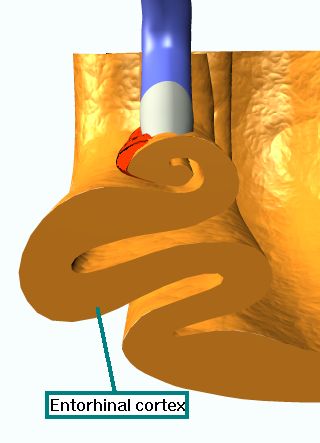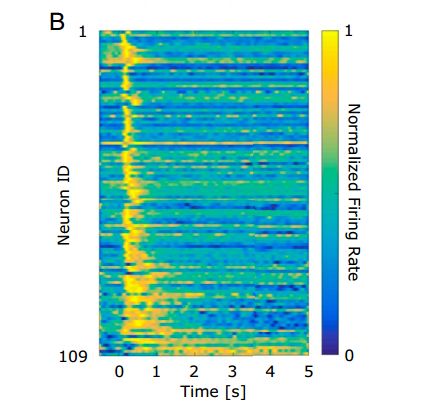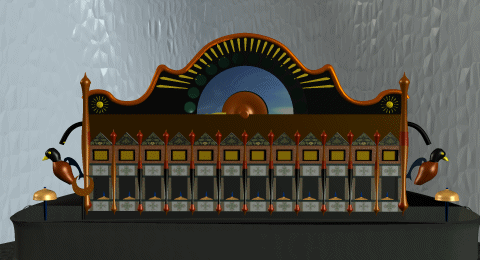Wednesday, August 05, 2020
Ridhwan in the brain
A study of memory vs time finds a new type of clock.
Monkeys were shown images while their brains were monitored with electrodes.
Summary:
 This graph shows what happens. Each horizontal row is the response of one neuron. Most neurons maintain their pulsing for about 1/3 second, but some hold the image for longer intervals, up to 5 seconds.
This graph shows what happens. Each horizontal row is the response of one neuron. Most neurons maintain their pulsing for about 1/3 second, but some hold the image for longer intervals, up to 5 seconds.
 Most human inventions follow Nature whether we know it or not. In this case it's hard to think of an invented timing mechanism that works the same way. Water clocks 'slide' through the hours with one moving part. Dial clocks 'roll' through the hours, again with one moving part, not a separate hand for each hour.
In electronics, timing is often done with an RC time constant. The RC circuit behaves like a pendulum with an escapement, charging up to a fixed threshold then triggering a switch that discharges the Capacitor. I can't think of a circuit that stacks up a sequence of increasing RC time constants, all starting at the same time.
There was ONE clock that registered each hour with its own neuron, starting at different times and sliding up, charging the time constant for each hour.
The Ridhwan, shown here running from midnight to 8AM.
Most human inventions follow Nature whether we know it or not. In this case it's hard to think of an invented timing mechanism that works the same way. Water clocks 'slide' through the hours with one moving part. Dial clocks 'roll' through the hours, again with one moving part, not a separate hand for each hour.
In electronics, timing is often done with an RC time constant. The RC circuit behaves like a pendulum with an escapement, charging up to a fixed threshold then triggering a switch that discharges the Capacitor. I can't think of a circuit that stacks up a sequence of increasing RC time constants, all starting at the same time.
There was ONE clock that registered each hour with its own neuron, starting at different times and sliding up, charging the time constant for each hour.
The Ridhwan, shown here running from midnight to 8AM.
 It's not quite the same, because the Ridhwan neurons start in sequence, not all at once. Still, it's closer to the brain than any other form of clock. Each hour has its own house, and in the original each house had a different picture on it. I got lazy and just showed alternate pictures on odd/even hours.
It's not quite the same, because the Ridhwan neurons start in sequence, not all at once. Still, it's closer to the brain than any other form of clock. Each hour has its own house, and in the original each house had a different picture on it. I got lazy and just showed alternate pictures on odd/even hours.
Many neurons in the entorhinal cortex were responsive to image onset, showing large deviations from baseline firing shortly after image onset but relaxing back to baseline at different rates. This range of relaxation rates allowed for the time since image onset to be decoded on the scale of seconds. Further, these neurons carried information about image content, suggesting that neurons in the entorhinal cortex carry information about not only when an event took place but also, the identity of that event. Taken together, these findings suggest that the primate entorhinal cortex uses a spectrum of time constants to construct a temporal record of the past in support of episodic memory.The entorhinal area is just a zone in the hippocampus, not really a distinct part. Here's a sectional view of the hippocampus, the 'seahorse-like' hemstitch along the bottom of the cerebrum. The arrow points to the entorhinal area.
 This graph shows what happens. Each horizontal row is the response of one neuron. Most neurons maintain their pulsing for about 1/3 second, but some hold the image for longer intervals, up to 5 seconds.
This graph shows what happens. Each horizontal row is the response of one neuron. Most neurons maintain their pulsing for about 1/3 second, but some hold the image for longer intervals, up to 5 seconds.
 Most human inventions follow Nature whether we know it or not. In this case it's hard to think of an invented timing mechanism that works the same way. Water clocks 'slide' through the hours with one moving part. Dial clocks 'roll' through the hours, again with one moving part, not a separate hand for each hour.
In electronics, timing is often done with an RC time constant. The RC circuit behaves like a pendulum with an escapement, charging up to a fixed threshold then triggering a switch that discharges the Capacitor. I can't think of a circuit that stacks up a sequence of increasing RC time constants, all starting at the same time.
There was ONE clock that registered each hour with its own neuron, starting at different times and sliding up, charging the time constant for each hour.
The Ridhwan, shown here running from midnight to 8AM.
Most human inventions follow Nature whether we know it or not. In this case it's hard to think of an invented timing mechanism that works the same way. Water clocks 'slide' through the hours with one moving part. Dial clocks 'roll' through the hours, again with one moving part, not a separate hand for each hour.
In electronics, timing is often done with an RC time constant. The RC circuit behaves like a pendulum with an escapement, charging up to a fixed threshold then triggering a switch that discharges the Capacitor. I can't think of a circuit that stacks up a sequence of increasing RC time constants, all starting at the same time.
There was ONE clock that registered each hour with its own neuron, starting at different times and sliding up, charging the time constant for each hour.
The Ridhwan, shown here running from midnight to 8AM.
 It's not quite the same, because the Ridhwan neurons start in sequence, not all at once. Still, it's closer to the brain than any other form of clock. Each hour has its own house, and in the original each house had a different picture on it. I got lazy and just showed alternate pictures on odd/even hours.
It's not quite the same, because the Ridhwan neurons start in sequence, not all at once. Still, it's closer to the brain than any other form of clock. Each hour has its own house, and in the original each house had a different picture on it. I got lazy and just showed alternate pictures on odd/even hours.Labels: Grand Blueprint, Morsenet of Things
